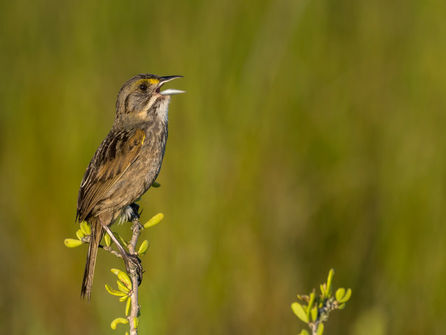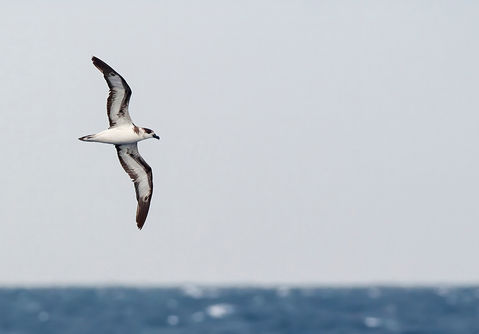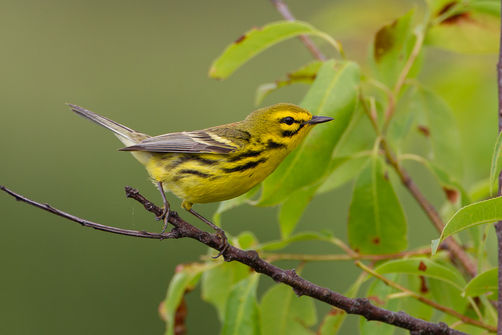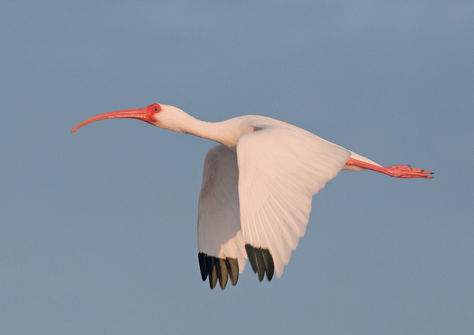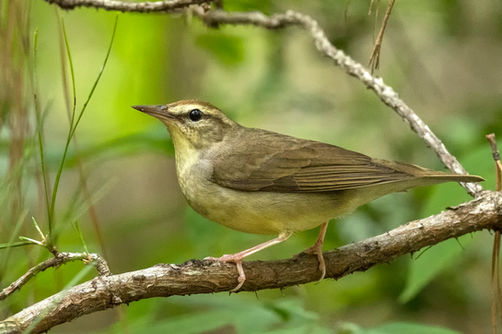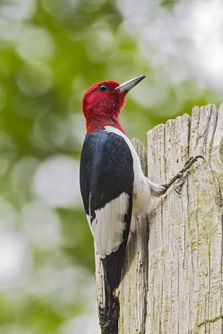North Carolina: Surf and Turf - Birding Tour
We are currently only offering this tour as a Custom Tour. Please Contact Us for more information
Tour Overview:
Are you good at keeping secrets? Well, we’re not! That’s why we’d like to invite you to join us in North Carolina in May! The destination has remained under-the-radar compared to higher-profile destinations like Arizona, Texas, and Florida, but the region offers some of the country’s most exciting birding, particularly on the pelagic front. The continental shelf cuts very close to shore at Cape Hatteras, and the warm Gulf Stream waters host an abundance of shearwaters, skuas, jaegers, storm-petrels, petrels, and marine mammals at this time of year. Our back-to-back pelagic trips will be unforgettable — don’t worry, it’s rarely rough! — and we’ll have plenty of time to explore white-sand beaches and coastal marshes as we commute along the postcard-beautiful Outer Banks. Still on the fence? You won’t be after we include pinewoods and freshwater swamps, unique habitats which will offer opportunities for southeastern specialties like Bachman’s Sparrow, Red-cockaded Woodpecker, Brown-headed Nuthatch, and Swainson’s and Prothonotary Warblers! With a perfect balance of land and sea, this ‘Surf and Turf’ tour will appeal to anyone who’s looking to explore off the beaten birding path. Throw in a wonderful climate and amazing seafood, and it should be smiles all around! Just don’t tell too many people - unless you want to bring them with you!
Looking for more information?
Other Tour Details:
Length: 7 Days
Starting City: Raleigh
Ending City: Raleigh
Pace: Moderate
Physical Difficulty: Easy/Moderate
Focus: Birding
Group size: 8 + 1 leader
Detailed Itinerary

Day 1: Arrival in Raleigh-Durham
After arriving in Raleigh-Durham International Airport (RDU), clients will take a free shuttle to our nearby hotel. There are no birding activities on this day, so feel free to arrive at any time. Dinner is not included in the tour fee for this night, so please eat wherever and whatever you please. Your guide will meet the group the following morning, the exact timing to be confirmed a few weeks in advance.
Day 2: Alligator River NWR, Bodie Island, Pea Island
After eating breakfast, we’ll depart the hotel and make multiple birding stops as we close the distance towards Hatteras, our ultimate destination. Our first taste of Coastal Carolina will be at Alligator River National Wildlife Refuge, an extensive reserve which presents a variety of woody and marshy habitats. Employing a mix of walking and driving, we’ll search for Wood Duck, Northern Bobwhite, and Wild Turkey. Songbirds should abound, and we could observe a number of eastern varieties including Great Crested Flycatcher, Prairie Warbler, Eastern Towhee, Blue Grosbeak, Indigo Bunting, and — appropriately — Carolina Chickadee and Carolina Wren! Bald Eagle and other raptors frequent the refuge, so we’ll have to keep our an eye skyward in case anything flies over!
Continuing east, we’ll lunch in Manteo and join the Outer Banks at Nags Head. Turning south onto the beachfront, we’ll make stops at Bodie Island and Pea Island, two regional crown jewels. Coastal marshes are present at both places, and we’ll scour those for American Black Duck, Clapper and King Rails, Tricolored Heron, and White Ibis. Upwards of 20 shorebirds are possible, American Oystercatcher, Piping Plover, and White-rumped Sandpiper among them. If we’re lucky, we might glimpse Black Skimmer feeding! It’ll be an action packed first day, and we’ll have dinner in Hatteras before resting up ahead of the first of two pelagic trips. This will be our first of three nights in Hatteras.
Days 3 - 4: Pelagic Trips from Hatteras
Hatteras is the best pelagic departure port on the East Coast, and the ‘Stormy Petrel' — a modern and comfortable vessel — will deliver us to the deepwater on consecutive days. Why two trips? Well, two reasons. First, trips are occasionally weathered-out because of high winds, and we want to ensure that we get at least one pelagic opportunity. Second, the ocean is highly-dynamic, and the birds turnover much faster than on land; two trips increases the possibility that we’ll encounter some of the less-common species. That said, most trips find Wilson’s Storm-Petrel, Leach’s Storm-Petrel, Band-rumped Storm-Petrel, Black-capped Petrel, Cory’s Shearwater, Greater Shearwater, Audubon’s Shearwater, Sooty Shearwater, and Common Tern. Though less common, South Polar Skua, Manx Shearwater, Northern Gannet, Bridled and Sooty Terns, South Polar Skua, and all three jaegers (Parasitic, Pomarine, Long-tailed) also make regular appearances. Trinidad Petrel, Fea’s Petrel and White-tailed and Red-billed Tropicbirds are within the realm of possibilities, and we can dream — however distantly — of mega-rarities like Bermuda Petrel (Cahow) and European Storm-Petrel. Chum brings some of the birds close to the boat, so photographic opportunities are often good. The days will be long, but Gulf Stream birding is something everyone should experience at least once (and hopefully twice on this tour).
Day 5: Ocracoke Ferries and Cedar Island NWR
Departing Hatteras, we’ll board the first of two ferries as we traverse the less-developed southern section of the Outer Banks. The first of these (1 hour) will deliver us to remote Ocracoke Island, and the second (2.5 hours) will return us to the North Carolina mainland at Cedar Island. We can expect Laughing, Herring, and Greater Black-backed Gulls aboard those vessels, and we could find as many as six species of tern — Least, Gull-billed, Caspian, Forster’s, Common, Sandwich, Royal — during our dual crossings. Brown Pelicans, Double-crested Cormorants, and herons and egrets should abound, and we’ll need to be on the look-out for fast-flying shorebirds like Black-bellied Plover and Ruddy Turnstone.
Reaching the mainland, we’ll explore Cedar Island National Wild Refuge for a variety of species including Cattle Egret, Green Heron, Osprey, Seaside Sparrow, Red-winged Blackbird, and Boat-tailed Grackle. From there, it will be onto Morehead City for a two-night stay, possibly with additional stops as time allows.
Day 6: Croatan National Forest
We will venture into a variety of wooded habitats on this last full day of birding, pine savanna chief among them. There we will seek the ‘pinewoods trio’ of Brown-headed Nuthatch, Bachman’s Sparrow, and the endangered Red-cockaded Woodpecker. While searching for those Southeastern specialties, we’ll also have chances for Northern Bobwhite, Red-headed and Pileated Woodpeckers, Eastern Wood-Pewee, Blue Jay, Brown Thrasher, Pine Warbler, and a host of other passerines. If we’re really lucky, we might even stumble into a roosting Common Nighthawk or Chuck-will’s-widow!
Moving to wetter areas, we’ll hope to find Swainson’s Warbler, arguably the most secretive of the North American wood warblers. We’ll almost certainly run into Prothonotary Warbler along the way, and Blue-gray Gnatcatcher, White-eye Vireo, Summer Tanager, and Yellow-breasted Chat are all in the area. If we knock-out all of our targets and have some extra time at the end of the day — we should be so lucky, right?!?! — we can swing through any number of coastal reserves during our afternoon return to Morehead City.
Day 7: Croatan mop-up, return to Raleigh, and departures
Despite the birding optimism expressed above, chances are we’ll need a few extra hours to seek out remaining species around Croatan. There are also several decent spots for Swainson’s Warbler between Morehead City and Raleigh-Durham, so we’ll be sure to hit those if that furtive bird eludes us closer to the coast. We’ll aim to be at RDU airport at 1pm, so clients should arrange to fly out any time after 3pm.
Trip Considerations
Pace: Easy to Moderate. Clients should expect early starts on each day. Breakfast will be eaten between 5:30-6:00am on most days, and we’ll spend the entire day out-and-about. There is no scheduled rest time, but clients will have ample opportunity to relax in the van as we move between birding locations. We’ll eat lunch between birding locations and enjoy dinner at or near our place of lodging.
Physical Difficulty: There will be some modest amount of walking on this tour, but anyone capable of covering 1 to 2 miles at relaxed pace will be fine. Topography is a non-issue because the Carolina Coastal plain is perfectly flat. We will spend two days at sea during the pelagics, so clients are encouraged to bring over-the-counter motion sickness medication or prescription patches. Our longest days of driving will be the first and last (4 hours and 3 hours, respectively), but we’ll break-up those hauls with multiple birding stops along the way.
Climate: Clients should prepare for daytime temperatures in the 70s and 80s and overnight temperatures in the 50s and 60s. May typically features 6 days of rain, so a rain coat is advisable. It — or another light jacket — can used for wind and sun protection on the pelagic trips.
Accommodations: Good throughout. All of the hotels and motels have typical amenities, including Wi-Fi.
Other Information
TRAVEL REQUIREMENTS: For US citizens, no special requirements are necessary to visit North Carolina. Citizens of Canada may enter the US with a valid passport, and do not need to obtain a visa. For citizens of the 38 countries on the visa waiver list (including the UK, Western Europe, Australia, New Zealand, Chile, and Japan – click here for the full list), you can enter the US with a valid passport and a completed Electronic System for Travel Authorization (ESTA), which should be applied for online IN ADVANCE OF THE TOUR. For all passports, the passport must be valid for at least six months past your intended stay. Citizens of all other countries will need to apply for a US visa. Travel requirements are subject to change; please double check with the nearest embassy or consulate or ask our office staff if you are unsure.
WHAT’S INCLUDED?: Accommodation from the night of day 1 to the night of day 6; meals from breakfast on day 2 to breakfast on day 7; reasonable non-alcoholic beverages with meals; safe drinking water only between meals (tap water is safe to drink in the US, and you are encouraged to fill your water bottles when able); Tropical Birding tour leader with scope and audio gear from the morning of day 2 to lunchtime on day 7; ground transport for the group in a suitable rental vehicle driven by the guide from the morning of day 2 to lunchtime of day 7; free airport shuttle bus on day 1; group airpor drop off at 1pm on day 7; tips for included meals; entrance fees to the sites mentioned in the itinerary; a printed and bound checklist to keep track of your sightings (given to you at the start of the tour – only electronic copies can be provided in advance).
WHAT’S NOT INCLUDED?: Optional tips to the tour leader; tips to baggage carriers if you require their services; flights; snacks; any Covid rests required; additional drinks apart from those included; alcoholic beverages; travel insurance; excursions not included in the tour itinerary; extras in hotels such as laundry service, minibar, room service, telephone calls, and personal items; medical fees; other items or services not specifically mentioned as being included.
Tour Reviews
*Participated on this Tour? Leave a Review! We would also love to see your favorite photo, upload it!



